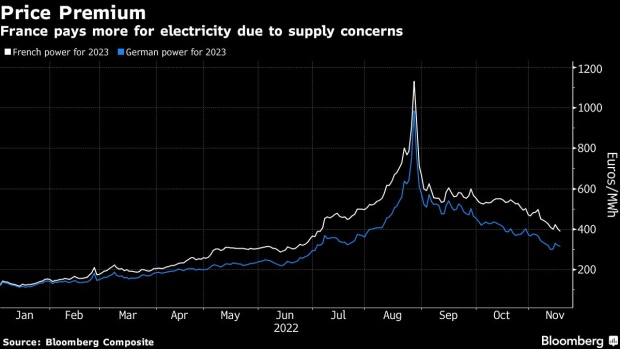Nov 19, 2022
France Is Losing Its Race to Fix the Reactors Europe Needs
, Bloomberg News

(Bloomberg) -- France’s nuclear industry is falling behind in efforts to get idled reactors running in time to escape blackouts and help Europe cope with the loss of Russian supplies this winter.
Once Europe’s biggest power exporter, France has made a bad situation even worse, and Europe’s energy crisis could intensify if Electricite de France SA comes up short with a plan to restart a quarter of its nuclear plants by mid-December. Its recent track record doesn’t look promising, and grid operator RTE warned on Friday that the risk of shortfalls in January is rising.
While the state-controlled utility has brought in emergency welding crews from the US and Canada to help fix unexpected cracks at a dozen units, the schedule is already well behind the plan of a few weeks ago. That means facing freezing temperatures without the backbone of its energy system intact.
“I know that EDF’s teams are extremely mobilized,” Prime Minister Elisabeth Borne said in Parliament on Wednesday. “We must however be prepared for any situation,” including the possibility of targeted blackouts this winter.
The issues have made France -- which typically relies on nuclear for more than two-thirds of its power -- vulnerable, despite lower exposure to Russian gas deliveries than Germany. Potential knock-on effects from nuclear-related shortfalls in France are keeping grid operators across the continent on alert, in case the European Union’s second-largest economy needs extra power.
France’s energy system is “unquestionably tighter than in previous years,” said Emeric de Vigan, vice president at consultant Kpler. Returning more than a dozen reactors to the grid in four weeks “seems impossible in terms of resources, both for EDF and for the nuclear safety authority.”
To limit the damage to the economy and head off social unrest, President Emmanuel Macron’s administration has earmarked at least €100 billion ($103 billion) to help businesses, consumers and public authorities cope with rising prices for power, natural gas and gasoline through next year.
As Russia squeezed fuel deliveries and given EDF’s chronic failure to keep maintenance deadlines, France has introduced sweeping plans aimed at reducing gas and power use by 10% over two years. The effort involves reducing indoor temperatures and lighting everywhere from government offices and museums to factories and supermarkets.
With nuclear shortages looming, the government is working on regulatory measures to raise production caps of existing hydro- and wind-power facilities and is in talks with German counterparts on an agreement that could increase its import capacity, officials told reporters on Friday.
The government is also looking to encourage or force companies to use back-up batteries and diesel generators. Reserve power systems for data centers alone could free up as much as 1 gigawatt of electricity, said the officials, who can’t be identified in line with briefing rules.
With 25 of its 56 reactors offline on Friday, EDF’s atomic output is about 25% below historic levels, pushing local power prices even higher than elsewhere in Europe.
There are signs that higher rates are destroying demand. Adjusted for weather effects, consumption in the four weeks ended Nov. 13 was down 6.6% from pre-pandemic levels, mostly due to manufacturers paring usage, according to grid operator RTE.
Read more: France Inc. Sounds Alarm on Lasting EU Scars From Energy Crisis
Relatively warm temperatures and full gas storage across the region have kept the situation under control, but a real test is coming. On cold winter days, which have yet to arrive in full force, electrical heating of homes and offices can suck up as much as 40% of supply.
EDF typically maintains 40 reactors a year, switching them off for quick refueling or extended safety checks and upgrades. But the schedule was thrown off by the Covid-19 pandemic, and then the disarray worsened when the company started discovering cracks in pipes in cooling systems late last year. Labor strikes in October added to the mess.
In May, EDF concluded that pipes at 16 of its 56 French reactors are prone to stress-corrosion cracks because of the complex design of safety injection systems, while older units are less affected. The unexpected findings forced the company to halt a dozen reactors and replace scores of radioactive pipe parts.
To accelerate fixes, EDF’s Framatome unit and maintenance company Westinghouse have flown in about a 100 of welders from North America to help the 500 metal workers and engineers locally.
RTE now sees higher risks of heading into January with atomic output 3 to 4 gigawatts lower than its previous forecast of 45 gigawatts as maintenance tends to take longer than planned, the grid operator said.
Hitting the January target is “unlikely, though it’s not impossible,” said Thomas Veyrenc, executive director at the grid operator. “It will depend on progress on heavy maintenance works and repairs.”
--With assistance from James Herron.
©2022 Bloomberg L.P.







